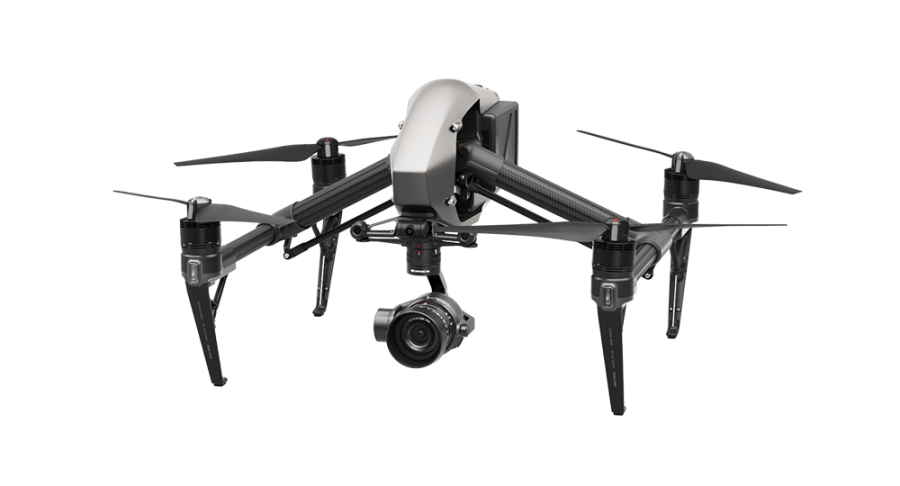Industry leader DJI has revealed two new offerings the Inspire 2 and the Phantom 4 Pro model – plus the new Zenmuse X4S and X5S cameras that are designed to operate with the updated Inspire drone.
Inspire 2
https://youtu.be/XBHuftMcmis
The Inspire 2 flies at a top speed of 67mph with acceleration to 50mph possible in four seconds. With a new dual battery system the flight time is said to be up to 27 minutes (with the X4S camera) compared to 18 minutes with the original Inspire drone.
The drone has an all-new image processing system, called CineCore 2.0, which should allow for processing of large files faster than ever before. Inspire 2 captures 5.2K video at a 4.2Gbps for Adobe CinemaDNG RAW videos. CineCore 2.0 supports a variety of video compression formats, including Adobe CinemaDNG, Apple ProRes 422 HQ (5.2K, 4K) and ProRes 4444 XQ (4K), H.264, and H.265. When recording 4K video in H.264 and H.265 the birate is up tp 100Mbps.
The dual-battery system is said to ensure that if one battery fails during a flight, the other will be able to provide power for a safe return to home. Stereo vision sensors have been included on the front and bottom of Inspire 2 for obstacle detection and infrared sensors that face up on top of the aircraft add protection when flying in enclosed spaces.
A redesigned propulsion system can carry the Inspire 2 through vertical camera moves, climbing at almost 20 feet per second and descending at almost 30 feet per second. Redundant systems provide reliability for the IMU, barometer, electronic speed controller communication and satellite navigation modules. The master and slave controller range now extends to 328 feet and users can switch between 2.4GHz and 5.8GHz frequencies to cut through any noise for greater signal stability.
The Inspire 2 has new intelligent flight modes – Spotlight Pro Mode, TapFly and ActiveTrack. Spotlight Pro Mode locks onto a subject during flight while the aircraft flies freely in another direction – and automatically rotates the aircraft to stay on the shot if the gimbal reaches its rotational limit. The drone’s forward-facing camera offers TapFly, which directs Inspire 2 to any point on the screen while avoiding obstacles along the way. ActiveTrack recognises common subjects such as people, cars and animals, sending Inspire 2 to follow behind, lead in front, circle above or track alongside while always flying forward, ensuring the forward-facing obstacle sensing system keeps the drone safe.
The Inspire 2 supports the new Zenmuse X4S and X5S cameras and will support additional DJI cameras in the future. The new Zenmuses are designed for aerial imaging and communicate directly with the aircraft’s gimbal and flight controllers.
The Zenmuse X4S has a 1-inch, 20-megapixel sensor with 11.6 stops of dynamic range and a 24mm equivalent focal length. It offers aperture control with an f/2.8-11 range and a mechanical shutter is said to cancel any rolling shutter distortion.
In comparison the Zenmuse X5S has a larger Micro Four Thirds sensor with 20.8 megapixels and 12.8 stops of dynamic range, supports eight lenses and shoots 20fps continuous burst DNG RAW (at 20.8MP). For on-the-ground shooting DJI has promised a handheld mount will be available for the Zenmuse X4S and X5S cameras in the future.
The Inspire 2 will be widely available from January 2017, at an RRP of £3,059.
Phantom 4 Pro
The Phantom 4 Pro drone includes a 1-inch 20-megapixel sensor and with ‘almost 12 stops of dynamic range’ it should help to bring out details and handle low-light shooting. Again it deploys a mechanical shutter to eliminate rolling shutter distortion in fast-moving scenes but technical details of how this works have yet to emerge from DJI.
The Phantom 4 Pro can capture slow-motion 4K video up to 60fps at a maximum bitrate of 100Mbps and it offers H.265 video compression, which should substantially improve video quality at the same bitrate.
The Phantom 4 Pro DJI has upgraded its FlightAutonomy obstacle avoidance system – this deploys three sets of visual systems that build a 3D map of obstacles in front, behind and below the unit, plus infrared sensing systems on both sides. FlightAutonomy can position, navigate and plan routes for the Phantom 4 Pro, enabling it to avoid obstacles in a sensing range of up to 98 feet at front and rear, even in complex 3D environments.
The drone’s high-performance battery technology is said to provide up to 30 minutes of flight time. It can fly at 31mph in P mode with obstacle avoidance in effect and has a top speed of 45mph when flown in sport mode.
Phantom 4 Pro’s new compact remote controller comes with an optional high luminance display, providing a clear live HD view from the main camera as well as essential telemetry data. The aircraft will automatically choose between 2.4GHz and 5.8GHz once powering on to gain a clear signal in areas with high radio interference. The controller has built-in GPS, a compass, a Micro-SD card slot and an HDMI port.
New intelligent flight modes on the Phantom 4 Pro include the ‘Draw Mode’ that allows operators to draw lines on the controller display and direct the Phantom 4 Pro to fly that route. ActiveTrack includes three new modes – New Circle, Profile and Spotlight.
Narrow sensing enhances obstacle avoidance sensitivity so the drone can fly through complex environments like narrow doorways. TapFly now works backwards and has a new ‘Free’ mode that allows pilots to set the direction of flight, turn the Phantom 4 Pro or tilt the gimbal without changing the direction of flight. With the new AR Route feature operators will be able to tell the flight route on the screen.
The Phantom 4 Pro will be available will be available for £1,589 with a standard controller.








